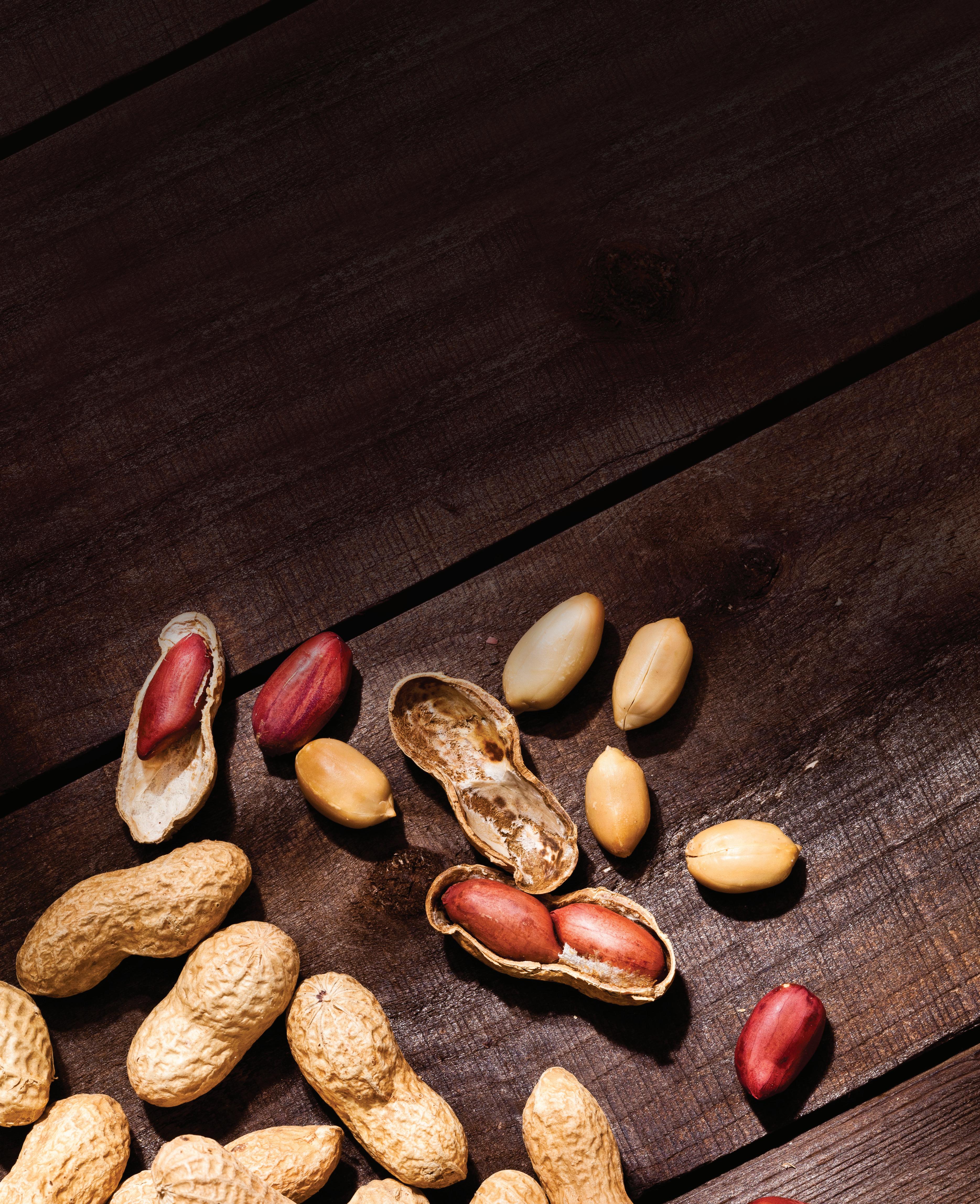
3 minute read
Power Food
{ POWER FOOD } Crunch Time
Almost any occasion is right for the delicious, nutritious, slightly noisy peanut.
Did you know that the peanut isn’t really a nut? Botanically speaking, it’s a legume, kin to beans and peas, because it grows in pods underground rather than in trees, where actual nuts develop. Known to science as Arachis hypogaea, peanuts originated in the Andes and were spread throughout Asia and Africa by Spanish and Portuguese explorers. In the 1700s they were brought to the North American continent; in ensuing centuries, with agriculture’s advance, they became a major commercial crop. More than 6 billion pounds of peanuts were produced in the U.S. last year, and China and India are even bigger producers.
Peanuts are a ubiquitous snack and a versatile food ingredient, as well as the basis of peanut butter and peanut brittle. These bad boys are so prevalent, with four main varieties (Runners, Virginias, Spanish and Valencias) and a wealth of seasonings (from honey roasted to spicy Cajun), that their sheer profusion may drive you absolutely legumes.
Peanuts, however, aren’t for everyone. Peanut allergies affect 1.2 percent of the U.S. population— and 2.5 percent of the kids. For them, consuming peanuts may produce an anaphylactic reaction that can be fatal. For the rest of us the peanut is an old reliable snack— traditional, accessible and more beneficial than you may realize.
POWER UP
If you’re looking to get protein without necessarily contemplating your food’s former face, you can’t go wrong with peanuts. The USDA reports that just one ounce can account for 15 percent of your daily recommended protein intake. But you needn’t be a vegetarian to appreciate peanuts. Relatively low in carbohydrates, they have a low glycemic index, which means they’re better for your blood sugar than, say, white bread or corn flakes. Peanuts can actually cut down on the risk of cardiovascular disease by giving you a healthy dose of vitamin E. They’re also a good source of another heart protector, vitamin B3 (alias niacin), which may help boost brain function too.
Peanuts are rich in minerals. One hundred grams—that’s about 3½ ounces—provide slightly more than half of your daily requirement of magnesium (good for muscle function, heart function and energy production) and just under half of your daily phosphorus (good for cell growth and the formation of teeth and bones). They’re fiber-intensive, and although they’re high in fat, it’s mostly a healthy monounsaturated fat that can help reduce the body’s levels of low-density lipoprotein (LDL), “bad” cholesterol. If you choose raw peanuts with skins attached, you’ll get the benefit of the skins’ antioxidants, which can help prevent cellular damage from free radicals.
Because they’re filling, peanuts can also be part of a weight-control regimen. But be aware that a handful of peanuts, 39 or so, has 170 calories, so if you munch heedlessly and the handfuls go on, calories can tally up fast. And if you’re someone who needs to watch your sodium intake—for instance, because of high blood pressure or known stroke risk—choose unsalted peanuts. An ounce of salted dry roasted peanuts contains about 280 milligrams of sodium, so that just a few ounces can rapidly approach the American Heart Association’s suggested daily maximum of 1,500 milligrams.
Peanut butter has the benefits of peanuts, but is often manufactured with salt, sugar and hydrogenated fats for flavor and ease in spreading. You can cut down on these additives by choosing “natural” peanut butter.
BUY/STORE/SERVE
Peanuts can be consumed raw, boiled, roasted or incorporated in a number of prepared dishes. Any grocery store is apt to sell them in the shell and shelled, salted and unsalted (check the baking aisle if the snack section doesn’t have them unsalted and shelled), and they’re a popular cooking ingredient in a number of cuisines around the world, combining a pleasant taste with a satisfying crunch. The shelf life of peanuts depends on whether they’ve had their hard exterior removed. With the shell they can last about four months in the pantry, and without it they’ll last four weeks. Either way, if you put them in the fridge they can endure about a year—if it takes you that long to consume them. “Sometimes you feel like a nut,” a TV ad jingle once sang. So why be technical? Grab a handful of peanuts—even if they’re really NINOs (nuts in name only).
DID YOU KNOW? In 1916, schoolboy Antonio Gentile won $5 in a contest for designing what became one of advertising’s most iconic images: Mr. Peanut.









